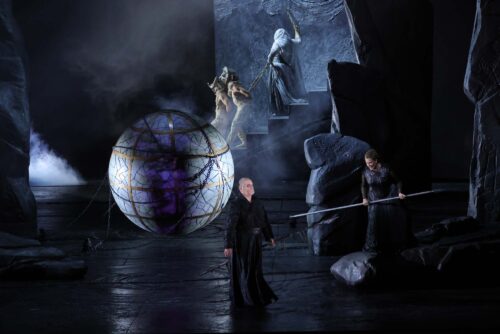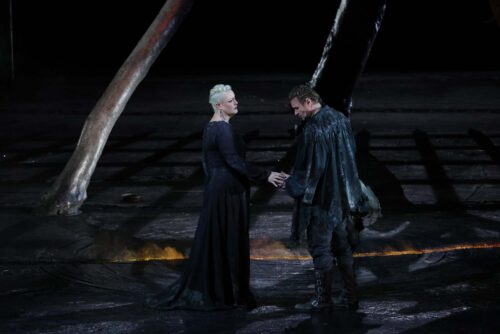 Italy Wagner, Die Walküre: Soloists, Teatro alla Scala Orchestra / Simone Young (conductor). Broadcast live (directed by Ella Gallieni) from La Scala, Milan, 12.2.2025 and available on demand until 19.2.2025. (JPr)
Italy Wagner, Die Walküre: Soloists, Teatro alla Scala Orchestra / Simone Young (conductor). Broadcast live (directed by Ella Gallieni) from La Scala, Milan, 12.2.2025 and available on demand until 19.2.2025. (JPr)

Last November having seen Sir David McVicar’s begin his new Ring cycle for Milan’s La Scala with a ‘puzzling’ Rheingold I wrote (review here) how McVicar was in his younger days ‘opera’s enfant terrible, a veritable provocateur if you will, but in the more recent times (the last decade or so) he seems, from what I have seen, to have settled into more of a Jonathan Miller last act cosiness. Nevertheless, at the end of this Rheingold memories returned to some of McVicar’s blood-soaked early productions as a figure – looking as if he had been flailed within an inch of his life – writhed at the bottom of the monumental Escher-like steps leading up to Valhalla’.
Nothing like that reappeared in the second instalment Die Walküre which – give or take some oddities – was as traditional as any Walküre you might have seen in the opera’s 150-year history. It was the sort of conventional Wagner production you would expect from the UK’s Longborough Festival Opera but obviously with more money thrown at it and with better technical facilities. There is nothing wrong of course with faithfully retelling the story – without a discernible message (yet?) – though it is very unusual in 2025. Especially when we are on the cusp of what Barrie Kosky has in store for us with his Walküre for The Royal Opera in two months’ time.
The story is so well-known how between the two works, Wotan – in disguise as Wälse – has fathered twins with a mortal woman because he needs a hero with free will. These become separated and reunite when Siegmund rescues Sieglinde from an abusive marriage and they fall in love. Wotan’s wife Fricka, the goddess of marriage, rails against this incest and commands him to order his daughter Brϋnnhilde – by Rheingold’s Erda – to ensure Siegmund dies in his fight with Sieglinde’s vengeful husband, Hunding. However, Brϋnnhilde disobeys Wotan because she is moved by Siegmund’s love for his twin sister. Wotan punishes his daughter by consigning her to sleep on a rock surrounded by flames until awoken – Sleeping Beauty-like – by a brave hero. Wotan by now knows the fleeing Sieglinde is pregnant with Siegfried.
The sets (McVicar and Hannah Postlethwaite) and costumes (Emma Kingsbury) are straight out of Sky’s Game of Thrones or the film Northman: A Viking Saga or a similar Norse saga on Netflix. Act I is in a castle with a portcullis at the rear; the stage picture is as dark as most of the costumes will be throughout the opera. At the centre are some twisted tree trunks and a convenient stump for characters to sit on. There are lots of (faux?) animal heads and skins for Hunding’s henchmen, whilst he has a skull mask. Siegmund needs a wolfskin and gets one, there (eventually) is the hilt of a sword conveniently visible in one of the trunks. Hunding is forever mistreating Sieglinde and his bedtime drink needs to be drugged and that happens with her in a spotlight. At the front of the stage is a rivulet of flames which flares up from time to time and often there is a smoky haze onstage.

For Siegmund’s invocation of Spring the portcullis rises and David Finn’s lighting now has a blueish tinge. At the end of the act when Siegmund and Sieglinde fall into each other’s arms, at the back of the stage two planets are shown colliding. The acting is variable with Klaus Florian Vogt’s Siegmund as a wide-eyed innocent, Elza van den Heever’s Sieglinde (a role debut) as a silent movie siren and Günther Groissböck’s Hunding, the blackest of black-hearted villains. Given the opportunity all three turn and sing to the audience with arms wide semaphoring.
At the start of Act II we are in a prehistoric stone circle with centrally a huge banded and chained-up sphere (ideas anyone?). Two performers dressed as ravens rise up before McVicar’s worst misstep in his staging when he has Brunnhilde’s horse Grane as a tall man on bouncy stilts with a metallic outline of a horse’s head. The horses for the Valkyries in Act III will also be like this and – like ‘Grane’ – they are a total distraction with their almost constant and irrelevant movement. On her entry the whip-wielding Fricka has two ‘rams’ (two actors with extravagantly horned masks and furry legs). When Brϋnnhilde appears she has a spear (as Wotan does too) and breastplate, would you by now expect anything else? There is the reappearance of a projected image of a hand in a large ring, as well as the four bare-chested men who now trundle the sphere away at the end of Wotan’s rant.
Brϋnnhilde confronts Siegmund as if she is initially sleep-walking. Lightning flashes herald the fight between Siegmund and Hunding who applies his coup de grâce as the dying Siegmund finally recognises his father. Wotan kills all Hunding’s men with a simple gesture before pursuing Brϋnnhilde. What has improved in this act is the standard of acting with the interaction between Wotan, Fricka and Brϋnnhilde more natural and less melodramatic than seen between the characters in Act I. Indeed, Michael Volle’s all-round consummate portrayal of Wotan had the dramatic quality of a King Lear.
In Act III the rabble-rousing octet of Valkyries looked like punks; but the scene is something of a mess because of those ‘horses’. There is a starscape behind a huge central rock which eventually revolves on the stage’s turntable (only occasionally used in this Walkϋre) to show the profile of a face. Is it the young Wagner (is it?) being used like his death mask was in Hans-Jürgen Syberberg’s 1982 Parsifal film. The ‘head’ will eventually split to show one of the large hands from Rheingold and with the help of those four men Brϋnnhilde is laid down in its palm and Wotan puts a mask on her. Projections have also included an aurora and the two planets separating before it all ends with flickering flames and a haze of red smoke before Wotan gets dressed up as a hooded Wanderer and moves off towards Siegfried.
The musical performance was extraordinarily impressive. Nevertheless, I have my doubts about Siegmund sung like Mozart’s Tamino, even though the legendary Wagner singer Alberto Remedios insisted the role must be sung lyrically. I have much admired Klaus Florian Vogt’s voice in the past, but as full-throated his cries of ‘Walse! Walse!’ were and wonderfully exultant ‘Winterstϋrme’ was, I longed for something more heroic and less sweet-sounding. Elza van den Heever as the emotionally vulnerable Sieglinde sang with ardent intensity and passion and sounded like a future Brϋnnhilde. I don’t believe Günther Groissböck is quite the singer he once was and negotiating the notes needed to sing his menacing Hunding made for a very mannered vocal performance. Camilla Nylund is possibly the leading Brϋnnhilde of this generation, however that is not to say that despite nailing all the notes of her fiendish ‘Hojotoho …’ entrance there wasn’t the occasionally squally moment. Nevertheless, Nylund brought real pathos and depth to pivotal moments like the Act II ‘Anunciation of Death’ and Act III’s ‘War es so schmählich’. Okka von der Damerau was a wonderfully authoritative, manipulative and rich-toned Fricka.
Michael Volle’s portrayal of Wotan always surpasses any other I have seen and heard. Despite outbursts of defiance his Wotan for McVicar was a world-weary, broken man which perfectly suits Volle who clearly cannot rush impetuously around a stage as he once did when younger. Impeccable diction and Lieder-like quality of expression makes his Wotan like none other today, even though it is clear he will stop singing the role sooner rather than later. Volle brought real drama to his long Act II monologue that held my attention like no one else’s before; the bitterness of his second ‘das ende!’ was chilling and there was little sign of fatigue in his exultant ‘Farewell’ to Brϋnnhilde.
Perhaps the real hero of this Die Walkϋre was Simone Young’s conducting of the generally fine La Scala orchestra. She was deservedly lauded at her curtain call as if she was Christian Thielemann whom Young was replacing. Eschewing succumbing to unnecessary grandiosity, Young conducted with typical intelligence, care, attention to detail, and persuasive forward momentum.
Jim Pritchard
Featured Image: The Act III ‘Ride of the Valkyries © Teatro alla Scala/Brescia e Amisano
Production:
Staging – Sir David McVicar
Sets – David McVicar & Hannah Postlethwaite
Costumes – Emma Kingsbury
Lighting – David Finn
Video projection – Katy Tucker
Choreography – Gareth Mole
Master martial arts / Circus performance – David Greeves
Cast:
Siegmund – Klaus Florian Vogt
Sieglinde – Elza van den Heever
Hunding – Günther Groissböck
Wotan – Michael Volle
Brünnhilde – Camilla Nylund
Fricka – Okka von der Damerau
Gerhilde – Caroline Wenborne
Helmwige – Kathleen O’Mara
Ortlinde – Olga Bezsmertna
Waltraute – Stephanie Houtzeel
Rossweisse – Eva Vogel
Siegrune – Virginie Verrez
Grimgerde – Eglė Wyss
Schwertleite – Freya Apffelstaedt

I saw this production last night, and I can say that I have rarely read a review that was as spot-on as this one. It articulated my views better than I could have ever done myself. Michael Volle was fantastic as Wotan. I have rarely seen such anger or weariness expressed on the operatic stage.
Saw the third and final evening with Simone Young conducting and agree with much of your review. So good to see a traditional staging (the horses notwithstanding – very distracting visually – not to mention their loud footsteps) and Volle was indeed terrific. Nylund is growing in the role, she hits all the notes, less audible on the lower register. Orchestra was pacey, perhaps just a little too quick for my taste, but sounded spectacular. Such was that rush that Simone started the second act before she was even standing on her podium!!
PS: If we don’t see Elza van den Heever as Brünnhilde before the end of the decade then I will be very shocked. By far the most surprising performance of the night, bravo